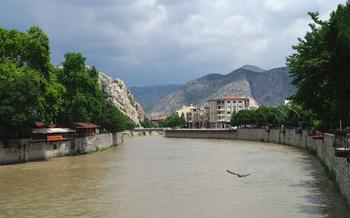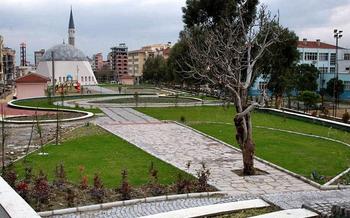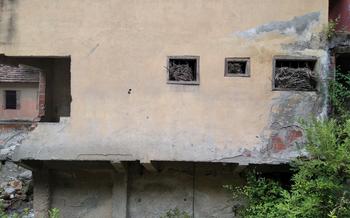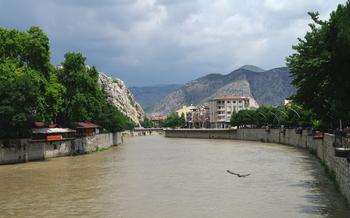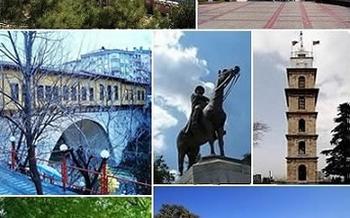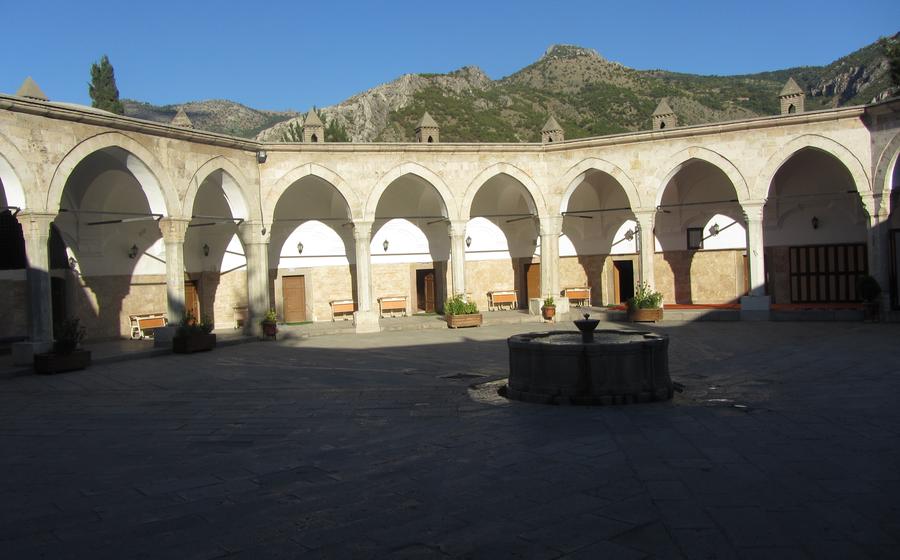
Büyük Ağa Medrese
- The Great Mosque of Amasya
- The History of Büyük Ağa Medrese
- The Architecture of Büyük Ağa Medrese
- The Hall of Prayer
- The Courtyard
- The Library
- Student Accommodation
- Faculty
- The Students: Diversity and Aspirations
- The Intellectual Atmosphere
- The Legacy of Büyük Ağa Medrese
- Visiting Büyük Ağa Medrese
- The Museum of Amasya
- Other Historical Sites in Amasya
- Insider Tip: Unveiling the Hidden Courtyard
The Great Mosque of Amasya
Standing as a testament to the rich architectural and religious heritage of Turkey, the Great Mosque of Amasya, also known as the Ulu Cami, holds a significant place in the city's history. Built in the 13th century during the reign of the Seljuk Sultanate, the mosque showcases a blend of Seljuk and Ottoman architectural styles, reflecting the region's diverse cultural influences. The mosque's imposing structure, adorned with intricate carvings and decorative elements, serves as a symbol of Islamic faith and devotion, attracting visitors from far and wide.
As one of the oldest and most important mosques in Amasya, the Great Mosque holds a deep religious significance for the local Muslim community. It is not only a place of worship but also a center for Islamic learning and education. The mosque's spacious prayer hall, adorned with elegant columns and arches, provides a serene and inspiring environment for the faithful to offer their prayers. The intricate mihrab, a niche in the wall that indicates the direction of Mecca, and the ornate minbar, a pulpit from which the imam delivers sermons, stand as exquisite examples of Islamic craftsmanship, adding to the mosque's grandeur.
The History of Büyük Ağa Medrese
The Büyük Ağa Medrese was commissioned by the Seljuk Sultan, Kayqubad I, in the early 13th century. Built as a center for Islamic education and learning, it quickly became one of the most important madrasahs in Anatolia. The madrasah was designed to accommodate up to 150 students and was staffed by a faculty of highly qualified scholars. The curriculum included a wide range of subjects, including Islamic law, theology, philosophy, and medicine.
The Büyük Ağa Medrese played a vital role in the development of Islamic scholarship and culture in Anatolia. It was a place where scholars from all over the region came to study and debate. The madrasah also produced a number of notable graduates who went on to become influential figures in the Islamic world.
Today, the Büyük Ağa Medrese stands as a testament to the rich history and cultural heritage of Amasya. It is a reminder of the important role that the madrasah played in the development of Islamic civilization.
The Architecture of Büyük Ağa Medrese
The architectural style of Büyük Ağa Medrese reflects the characteristic features of Seljuk architecture. The madrasah is constructed using a combination of stone, brick, and tile, materials commonly used in Seljuk buildings. The exterior facade of the madrasah is adorned with intricate carvings and decorative tiles, showcasing the refined craftsmanship of the Seljuk artisans.
The layout of the madrasah adheres to the traditional design of Islamic educational institutions. The main entrance leads into a spacious courtyard, surrounded by covered galleries and arcades supported by slender columns. The courtyard serves as a gathering space for students, providing a tranquil and shaded area for contemplation and exchange of ideas.
The prayer hall is the focal point of the madrasah, located at the far end of the courtyard. It features a rectangular layout with a vaulted ceiling supported by rows of columns and arches. The mihrab, a niche indicating the direction of prayer, is intricately carved with geometric and floral motifs, highlighting the importance of this sacred space.
The madrasah also includes a library, student accommodation, and faculty offices, all arranged around the central courtyard. These spaces are designed to foster a conducive learning environment, where students can reside, study, and engage in intellectual pursuits within the confines of the madrasah.
The Hall of Prayer
The heart of the madrasah, the hall of prayer, is a stunning testament to the architectural and artistic prowess of the Seljuk period. Its design and layout are a reflection of the importance placed on religious rituals and devotion in the madrasah. The hall features rows of columns and arches that support the ceiling, creating a sense of grandeur and spaciousness. The use of columns also allows for the creation of aisles, facilitating the movement of worshippers during prayers.
The decoration of the hall is intricate and elaborate, showcasing the finest craftsmanship of the Seljuk artisans. The mihrab, the niche indicating the direction of Mecca, is adorned with intricate carvings and tile work, symbolizing the reverence accorded to the sacred space. The minbar, the raised platform used by the imam to deliver sermons, is another highlight of the hall, adorned with intricate carvings and inlaid with mother-of-pearl. These decorative elements not only enhance the aesthetic beauty of the hall but also serve as reminders of the religious significance of the space.
The Courtyard
The courtyard of Büyük Ağa Medrese is a tranquil and serene space, designed to provide a conducive environment for contemplation and study. The layout of the courtyard is symmetrical, with a central fountain surrounded by four gardens. The gardens are planted with a variety of trees, shrubs, and flowers, which create a vibrant and colorful display.
The courtyard is also surrounded by covered arcades, which provide shade and shelter from the sun and rain. These arcades are supported by slender columns, which create a sense of lightness and airiness. The arcades are also decorated with intricate carvings and tilework, which add to the overall beauty of the courtyard.
The courtyard serves as a gathering space for students and faculty, who use it for socializing, studying, and relaxing. It is also a popular spot for visitors, who come to admire the architecture and the peaceful atmosphere.
The Library
The library of Büyük Ağa Medrese was one of the most significant and well-stocked libraries in the Islamic world. It housed a vast collection of books and manuscripts covering a wide range of subjects, including theology, law, philosophy, history, science, and literature. The library was a hub of intellectual activity and scholarship, and scholars from all over the region came to study and research in its collection.
The library was founded in the 13th century by the Seljuk vizier Büyük Ağa, who was a passionate patron of learning and education. He spared no expense in acquiring rare and valuable books and manuscripts, and the library quickly became one of the most renowned in the Islamic world. The library was open to all students and scholars, regardless of their background or affiliation, and it played a vital role in the dissemination of knowledge and the development of Islamic scholarship.
The library was housed in a dedicated building within the madrasah complex. The building was designed to provide a conducive environment for study and research, with ample natural light and ventilation. The books and manuscripts were stored in wooden shelves, and there were reading desks and chairs for scholars to use. The library also had a dedicated staff of librarians who were responsible for maintaining the collection and assisting scholars with their research.
The library's collection was particularly strong in the fields of theology, law, and philosophy. It contained many rare and valuable manuscripts, including some that were unique to the library. The collection also included a number of non-Islamic works, such as translations of Greek and Roman classics. The library was a valuable resource for scholars from all over the region, and it played a vital role in the development of Islamic scholarship.
Student Accommodation
The student accommodation at Büyük Ağa Medrese was designed to provide a comfortable and conducive living environment for the students. The rooms were arranged around the courtyard, each with its own entrance and a small window overlooking the courtyard. The rooms were furnished with a simple bed, a desk, and a few shelves.
The students were responsible for cleaning and maintaining their own rooms. They also had access to shared facilities such as a kitchen, a dining hall, and a bathhouse. The kitchen was equipped with basic cooking utensils and a communal oven. The dining hall was a large, open space where the students could eat their meals together. The bathhouse was a welcome luxury in a time when bathing was not a common practice.
The daily routine of the students was quite rigorous. They would wake up early in the morning for prayers and then attend classes throughout the day. In the evenings, they would study in their rooms or attend evening lectures. The students were expected to be respectful and obedient to their teachers and to follow the rules and regulations of the madrasah.
The student accommodation at Büyük Ağa Medrese played an important role in the madrasah community. It was a place where the students could live and study together, forming close bonds that would last a lifetime. The accommodation also helped to create a sense of community and belonging among the students.
Faculty
The faculty of Büyük Ağa Medrese was composed of highly qualified and experienced scholars and theologians. They were chosen for their expertise in various Islamic disciplines, including Quranic studies, Hadith, jurisprudence, theology, and philosophy. The faculty members were also known for their piety and devotion to Islamic teachings.
The faculty played a crucial role in shaping the intellectual atmosphere of the madrasah. They were responsible for teaching the students the various Islamic sciences and instilling in them a deep understanding of the Islamic faith. The faculty also encouraged students to engage in intellectual debates and discussions, which helped to foster a vibrant and dynamic learning environment.
The faculty of Büyük Ağa Medrese was instrumental in producing some of the most prominent Islamic scholars and thinkers of the time. Many of the madrasah's graduates went on to become influential figures in the religious, intellectual, and political life of the Ottoman Empire.
The Students: Diversity and Aspirations
The students who attended Büyük Ağa Medrese came from diverse backgrounds and social statuses. Some were the sons of wealthy merchants or government officials, while others came from more modest families. Some were from the local area, while others traveled from distant lands to seek knowledge at the madrasah.
Students chose to study at Büyük Ağa Medrese for various reasons. Some were drawn by the reputation of the madrasah's faculty and the quality of education it offered. Others came to study specific subjects, such as Islamic law, theology, or philosophy. Still, others were motivated by a desire to deepen their understanding of Islam and to become better Muslims.
Life as a student at Büyük Ağa Medrese was challenging but rewarding. The students lived in simple accommodations and followed a rigorous schedule of study. They attended lectures and participated in debates and discussions. They also spent time memorizing the Qur'an and studying the hadiths of the Prophet Muhammad.
The madrasah education had a profound impact on the lives of the students. It provided them with the knowledge and skills they needed to become successful scholars, religious leaders, and teachers. It also helped them to develop a strong sense of community and belonging. Many of the students went on to make significant contributions to Islamic scholarship and culture.
The Intellectual Atmosphere
Büyük Ağa Medrese was renowned for its vibrant intellectual atmosphere, where learning and scholarship were highly valued. The madrasah attracted a diverse group of scholars and students who engaged in lively intellectual debates and discussions. These discussions covered a wide range of subjects, including theology, philosophy, law, and literature. The exchange of ideas and knowledge between teachers and students created a stimulating and intellectually enriching environment.
The madrasah's library played a crucial role in fostering this intellectual atmosphere. It housed a vast collection of books and manuscripts on various subjects, providing students and scholars with access to a wealth of knowledge. The library also served as a meeting place for scholars, who would gather to discuss their research and ideas.
Büyük Ağa Medrese's intellectual atmosphere had a profound impact on the broader intellectual landscape of the region. The madrasah's scholars and students were instrumental in disseminating knowledge and promoting intellectual discourse throughout the Islamic world. The madrasah's legacy continues to this day, as it remains a center for Islamic learning and scholarship.
The Legacy of Büyük Ağa Medrese
The Büyük Ağa Medrese played a vital role in disseminating Islamic knowledge and scholarship throughout the region. It was a center of learning and intellectual inquiry, attracting students and scholars from across the Islamic world. The madrasah's curriculum covered a wide range of subjects, including Islamic law, theology, philosophy, and science. The faculty was renowned for its expertise and erudition, and the graduates of the madrasah went on to become influential religious leaders, scholars, and administrators in the Ottoman Empire.
Beyond its educational impact, the madrasah also played a significant role in shaping the religious and intellectual landscape of the region. It was a place where different ideas and perspectives were exchanged, and where new knowledge was created. The madrasah's intellectual atmosphere fostered a spirit of inquiry and critical thinking, which contributed to the development of Islamic culture and civilization.
The legacy of the Büyük Ağa Medrese is still felt today. The madrasah's architectural grandeur and historical significance make it a popular tourist destination. It is also a reminder of the rich Islamic heritage of Turkey and the important role that education played in the development of the Ottoman Empire. The madrasah's enduring legacy serves as a testament to its impact on the intellectual and cultural landscape of the region.
Visiting Büyük Ağa Medrese
Büyük Ağa Medrese is open to visitors daily from 9:00 AM to 6:00 PM. The entrance fee is a small fee, and there are guided tours available for those who want to learn more about the history and architecture of the madrasah.
To make the most of your visit, plan to spend at least an hour exploring the madrasah. Be sure to take your time to admire the intricate carvings and motifs that adorn the building. Pay special attention to the prayer hall, which is one of the most beautiful and impressive spaces in the madrasah.
After visiting the madrasah, be sure to spend some time exploring the surrounding area. The Amasya Museum is just a short walk away and is worth a visit for its collection of artifacts and exhibits on the history and culture of Amasya.
The madrasah is most impressive during the spring and summer months when the weather is warm and sunny. However, it is also worth visiting in the winter when the snow-capped mountains provide a stunning backdrop to the madrasah.
The Museum of Amasya
Located in the heart of the city, the Museum of Amasya stands as a testament to the rich cultural heritage of this ancient land. Housed within the walls of a former Ottoman palace, the museum boasts a diverse collection of artifacts and exhibits that narrate the captivating story of Amasya's past.
As you step inside, you'll be greeted by a treasure trove of archaeological wonders, meticulously organized to showcase the region's diverse history. From prehistoric tools and pottery to intricate coins and jewelry, each artifact offers a glimpse into the lives of those who inhabited this land centuries ago.
Among the highlights of the museum's collection are the stunning bronze sculptures unearthed from the nearby Amasya Castle. These exquisite works of art, dating back to the Hellenistic period, depict gods, goddesses, and mythical creatures with remarkable detail and finesse.
Another highlight is the collection of Islamic manuscripts, which includes rare and beautifully illuminated copies of the Quran and other religious texts. These manuscripts provide valuable insights into the region's rich Islamic heritage and the contributions of local scholars to the development of Islamic thought and culture.
The Museum of Amasya is not merely a repository of ancient artifacts; it is a vibrant space that actively engages visitors in the exploration of history. Through interactive exhibits, multimedia presentations, and educational programs, the museum brings the past to life, making it accessible and relevant to visitors of all ages.
Whether you're a history buff, a culture enthusiast, or simply someone curious to learn more about this fascinating region, the Museum of Amasya is a must-visit destination. Immerse yourself in the rich tapestry of Amasya's heritage and discover the stories that have shaped this city into the vibrant cultural hub it is today.
Other Historical Sites in Amasya
Amasya Castle stands as a testament to the city's rich and storied past. Perched atop a hill overlooking the city, the castle offers breathtaking panoramic views of Amasya and the surrounding countryside. Its imposing walls and towers, built during the Byzantine era, have withstood the test of time and tell tales of battles and conquests. Explore the castle's chambers and courtyards, and let your imagination transport you back to a time of knights and princesses.
Gökçebel Cave beckons with its hidden depths and natural wonders. Located just a short drive from Amasya, this enchanting cave system invites you to embark on an underground adventure. Marvel at the stalactites and stalagmites that adorn the cave's chambers, creating a surreal and awe-inspiring spectacle. Wander through its winding passages and discover hidden chambers that reveal the secrets of the earth.
Kral Kaya Tombs offer a glimpse into the ancient burial customs of Amasya's past inhabitants. Carved into the rocky cliffs overlooking the city, these tombs date back to the Hellenistic period and feature intricate facades and inscriptions. Explore the tombs and learn about the lives and legacies of the individuals laid to rest here.
These historical sites, along with Büyük Ağa Medrese, form an integral part of Amasya's cultural heritage. They offer visitors a glimpse into the city's rich history and diverse cultural influences.
Insider Tip: Unveiling the Hidden Courtyard
As you wander through the Büyük Ağa Medrese, take a moment to seek out a hidden gem nestled within its walls – the concealed courtyard. Tucked away from the main thoroughfares, this secluded oasis offers a serene escape from the bustling madrasah.
In the heart of the courtyard, a tranquil fountain gently cascades, its soothing sounds creating a calming ambiance. Surrounded by lush greenery and fragrant flowers, the air is filled with a sweet aroma. Benches are strategically placed, inviting visitors to pause and soak in the tranquility.
This hidden courtyard is the perfect place to escape the crowds and find a moment of solace. Whether you choose to sit in quiet contemplation or engage in lively conversation with fellow travelers, the courtyard provides an intimate setting for reflection and connection.
So, as you explore the wonders of the Büyük Ağa Medrese, don't miss the opportunity to uncover this secret sanctuary. Let the serenity of the hidden courtyard wash away your worries and leave you feeling refreshed and rejuvenated.
